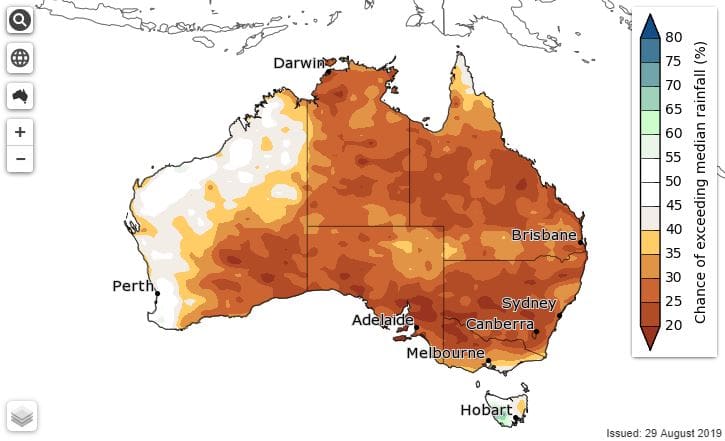MOST of Australia is likely to experience warmer and drier than average conditions in the coming three months, according to the Bureau of Meteorology’s Spring Outlook released today.
The warm and dry outlook for the spring season follows warmer than average winter days for most of Australia, cool nights in many areas, and one of the driest winters on record for large parts of the country.
The Bureau’s head of long-range forecasting Dr Andrew Watkins said the coming three months were unlikely to deliver significant widespread rainfall.
“Unfortunately, the outlook is not indicating an easing of conditions in drought areas.” Dr Watkins said.
“But a drier than average outlook is not an outlook for no rain at all. Significant rainfall events are always possible, so it’s important to keep a close eye on the seven-day forecast.
“Winter was wet in parts of southern Victoria and western Tasmania, as well as central Queensland, but for most areas experiencing long-term rainfall deficiencies there was little relief.”
The outlook for temperature in the coming three months shows most of Australia is likely to see warmer days and nights in the coming three months, with only isolated parts of southern Australia and Tasmania likely to see cooler conditions.
Dr Watkins said a positive Indian Ocean Dipole (IOD) was the main climate driver impacting the outlook.
“A positive IOD means we have cooler than average waters between Australia and Indonesia. This generally means less cloud than normal forms to the northwest of Australia, resulting in less rainfall and higher than average temperatures over central and south-eastern Australia during winter and spring.
“El Nino Southern Oscillation (ENSO), the other main driver, remains neutral, meaning it’s having little influence over Australia’s climate right now.”
State outlooks for spring:
New South Wales
Daytime temperatures are likely to be warmer than average across the entire state. Overnight temperatures are also likely to be warmer than average across most of the state, with the highest likelihood in the north.
A higher likelihood of drier than average conditions in the coming three months across most of the state.
Over winter, temperatures in NSW have been above average. Daytime temperatures are likely to rank among the warmest 10 winters on record. Rainfall has been below average.
Likely to be among Sydney’s three warmest winters on record for daytime temperatures, while rainfall was close to average.
Victoria
Daytime temperatures are likely to be warmer than average across most of the state with the highest likelihood in the north. The chances of overnight temperatures being above average are roughly equal across most of the state.
A higher likelihood of drier than average conditions across most of the state.
Over winter, temperatures in Victoria have been above average. Rainfall has been below average.
In Melbourne, daytime and overnight temperatures were above average, with rainfall also generally above average.
ACT
Daytime and overnight temperatures are likely to be warmer than average.
A higher likelihood of drier than average conditions.
Over winter, daytime temperatures were very much above average. Rainfall was very much below average.
Tasmania
No strong push towards either above or below average daytime and overnight temperatures.
A higher likelihood of wetter than average conditions in western parts of the state, with a higher likelihood of drier than average conditions for eastern parts of the state.
Over winter, both daytime and overnight temperatures were above average.
Rainfall was above average, however on the east coast it was very much below average.
Hobart had a warm winter with both daytime and overnight temperatures very much above average. Winter rainfall was slightly above average.
South Australia
Daytime temperatures are likely to be above average. Overnight temperatures are likely to be above average in the north of the state, with no strong push over southern parts of the state.
Drier than average conditions are likely over most of the state.
Over winter, Daytime temperatures were above average. Overnight temperatures were below average, and the coolest since 2012.
Rainfall was below average.
In Adelaide, daytime temperatures were close to average, while overnight temperatures were above average. Rainfall was close to average.
Western Australia
Daytime and overnight temperatures are likely to be above average for most of the state.
Drier than average conditions are likely through southern parts of the state. No strong push towards wetter or drier than average conditions for the large parts of the Pilbara and Kimberley region, as well as parts of the southwest.
Over winter, temperatures were very much above average. It’s likely to be among the three warmest winters on record.
Rainfall was below average.
In Perth, rainfall was near average while temperatures were above average.
Northern Territory
Daytime and overnight temperatures are likely to be above average across the state.
Drier than average conditions are likely across the state.
Over winter, daytime and overnight temperatures were below average.
Rainfall was below average.
In Darwin, daytime temperatures were warmer than average, while overnight temperatures were cooler than average. Rainfall was below average.
Queensland
Daytime temperatures are likely to be above average across the state. Overnight temperatures are likely to be above average across the state, but there is a reduced likelihood for parts of the northeast coast.
Drier than average conditions are likely for most of the state.
Over winter, daytime and overnight temperatures were above average.
Rainfall was below average and especially dry in the south.
Brisbane had a particularly warm winter. Daytime temperatures are likely to be warmest on record, while overnight temperatures will likely be among the three warmest on record. Rainfall was below average.
Source: BOM


HAVE YOUR SAY